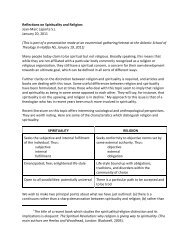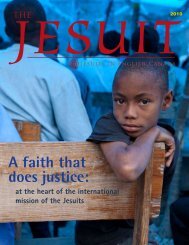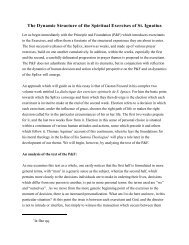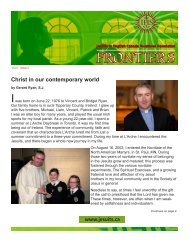Understanding the spiritual journey: from the classical tradition to the ...
Understanding the spiritual journey: from the classical tradition to the ...
Understanding the spiritual journey: from the classical tradition to the ...
Create successful ePaper yourself
Turn your PDF publications into a flip-book with our unique Google optimized e-Paper software.
This is <strong>the</strong> way; this is <strong>the</strong> order. First we cast ourselves at his feet and deplore beforeGod who made us <strong>the</strong> evil we have done. Secondly we reach out for <strong>the</strong> hand which willlift us up, which can straighten our trembling knees. Last, when we have obtained that,with many prayers and tears, <strong>the</strong>n perhaps we shall dare <strong>to</strong> lift our faces <strong>to</strong> <strong>the</strong> mouthwhich is so divinely beautiful, fearing and trembling, not only <strong>to</strong> gaze upon it but even<strong>to</strong> kiss it. For "Christ <strong>the</strong> Lord is a spirit before our face". When we are joined with himin a holy kiss we are made one with him in spirit through his kindness. (III,5)The first comes at <strong>the</strong> beginning of our Christian life. The second is given <strong>to</strong> those whomake progress. The third is a rare experience, given only <strong>to</strong> <strong>the</strong> perfect...threeaffections or stages in <strong>the</strong> progress of <strong>the</strong> soul: first <strong>the</strong> forgiveness of sins, <strong>the</strong>n grace<strong>to</strong> do good, <strong>the</strong>n <strong>the</strong> presence of him who forgives, <strong>the</strong> benefac<strong>to</strong>r, is experienced asstrongly as it can be in a fragile body. (IV,1)This text is taken <strong>from</strong> Bernard’s Commentary on <strong>the</strong> Song of Songs, when he comments onverse 1:1: “let him kiss me with <strong>the</strong> kiss of his mouth”. We note at <strong>the</strong> outset that Bernard isspeaking of a succession of stages ra<strong>the</strong>r than functions that can be exercised simultaneously:The Beginners The Proficient The PerfectThis stage evokes <strong>the</strong> imageof <strong>the</strong> woman, whose sinswere forgiven,who castsherself at <strong>the</strong> feet of Jesus,kisses <strong>the</strong>m, and anoints<strong>the</strong>m with oil. It is <strong>the</strong> stagein which we are converted,forgiven, turned away <strong>from</strong>sin <strong>to</strong>wards God.The second stage evokes apassage where Jesus lifts up<strong>the</strong> mo<strong>the</strong>r-in-law of Peter,cured of her illness. It is <strong>the</strong>stage in which we carry onour earthly pilgrimage with<strong>the</strong> constant help of Christ,who illuminates our path.The third stage which speaksof <strong>the</strong> kiss of <strong>the</strong> mou<strong>the</strong>vokes that union with Godfor which we all crave. ForBernard it involves <strong>the</strong>contemplation of Christ’sface, but that contemplationends in a kiss of holy union.1.2 Roots of this <strong>tradition</strong>: Bernard was far <strong>from</strong> <strong>the</strong> first <strong>to</strong> devise stages for <strong>the</strong> <strong>spiritual</strong><strong>journey</strong>. Already in <strong>the</strong> 4 th century Eastern Church Evagrius had done so for those seekingperfection in monastic observance. The language and concerns of <strong>the</strong> Eastern Church wereshaped by <strong>the</strong> Greek culture’s philosophical quest for wisdom. Salvation in this context aboveall means liberation <strong>from</strong> <strong>the</strong> distractions, cares, concerns of this life, and entry in<strong>to</strong> aunimpeded and uninterrupted contemplative union with God, who is unchanging and eternal,as far removed as can be <strong>from</strong> <strong>the</strong> <strong>to</strong> and fro, ups and downs, instabilities of life in thiseveryday world. Monks fled in<strong>to</strong> <strong>the</strong> desert <strong>to</strong> find this liberation.The Western <strong>tradition</strong> is more practical, ascetical, with sharper focus on <strong>the</strong> growth of divinecharity within human beings. The Eastern and Western Church, however, in <strong>the</strong>se earliercenturies were in constant contact with one ano<strong>the</strong>r, and between <strong>the</strong>m we find not so muchdivergences as differences of emphasis. Augustine of Hippo (354-430), <strong>the</strong> early Western<strong>the</strong>ologian who had <strong>the</strong> most influence in <strong>the</strong> Middle Ages, paved <strong>the</strong> way for <strong>the</strong> for <strong>the</strong>










